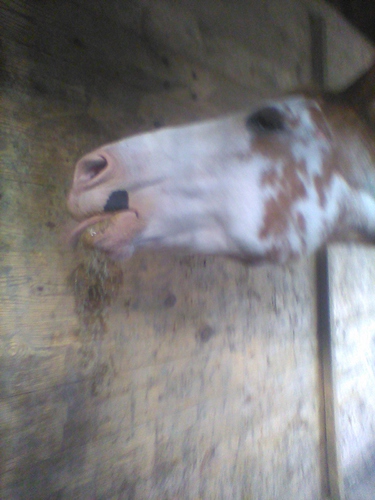What does this mean? Are you worming based on fecal egg counts?
Thank you! I’ll check it out! Any grain or just the chop?
When the vet is out we have her do the egg count. However, in between since the cost is relatively low, we do use paste wormer based on the season.
How much water are you using to soak the grain? I had a Paint gelding whose teeth were in good condition and he didn’t have problems eating dry grain. I moved him to a new barn where the BO was shocked I didn’t soak it. He liked it soaked, but one day someone dumped way too much water in. It was soup. He lapped it up and then licked the stall wall and grills and coated them with the soaked grain. When it was dry he often would nibble some off the wall, for a snack I guess. The BO’s husband was unconcerned when I asked him about cleaning the stall. “Don’t worry, we’ll pressure wash it one day.” He never did, and we put the horse down 18 months later at age 28. I assume he did it before the new tenant moved in. I was told that they decided to give that stall to the oldest horse. It had southern sun and an oversize runout.
We had a 38 year old smaller quarter horse on the property when we bought it who was skin and bones. (We inherited him as a boarder).
He was getting 9 lbs of senior feed over 3 feedings when we got here, but required 16 lbs of senior feed spread over 4 feedings to gain weight. We also added corn oil and alfalfa when he would eat it.
Often people don’t feed enough senior feed to account for the inability to eat hay. If a “normal” thousand pound horse eats 15-20 lbs of hay per day, depending on the type of hay that’s ~16,000 calories. In order to make that up with a complete senior feed (which normally has 1200-1600 calories per pound) you are adding a LOT more than you expect of it (roughly 16 lbs if no hay can be consumed). If the horse required grain when they were younger to maintain condition, then you need still more.
The trick I’ve struggled with seniors is getting them to keep eating the quantity of food you want them to eat. Rotating senior feeds seems to help. More frequent meals helps. And pain can really make that whole thing harder.
I think this is a very good point. Purina has a calculator on its website that helps you calculate your horse’s calorie needs. So a horse who is 900 lbs and doesn’t work needs around 12,400 calories a day. You could look at the number of calories in your feed and see how close you are to that requirement.
that’s not a good practice, unless FECs are regularly showing the horse is a high shedder. What are the FEC results typically? What are you using, and what does “based on the season” mean?
I think my brevity when answering about worming is possibly causing some questions. I am answering a lot of different responses which I am thankful for but sometimes answering short since I am addressing different topics.
By no means is our current plan of action with this new mare, “practice or routine”
I will elaborate. When we first got her she was classified a high shedder based on her egg count. She was treated.
In Florida, or even just us personally, we test our other horses in the fall routinely. NORMALLY (since we have been more pasture managment focused) our standard two horses are “low” shedders so typically they “may” only get 1 treatment per year. OF course this depends on results and we treat for the year accordingly. Typically this is a paste with praziquantel .
What I meant by based on season is, in Florida we “typically” dont have to worry about parasites during the summer months due to the extreme temperatures we reach.
Due to her results and time of year she has been treated about every few months or so.
With this old gal, since she came from a horrible home, she had to be tested/treated when she arrived and then again she was treated in the fall (September, with no testing). This was our choice to just do as precautionary since her results were so high when we got her. We decided to schedule her worming (and testing) more frequently initially until we see low results produce. She again was tested a few months ago (moderate/almost low) and received treatment.
We do believe the elevated counts were a few things but also we believe the set up we had for her/ where she was being kept while we were trying to put the weight back on her contributed.
We have since made many changes to her stall set up as well as her pasture.
I am not an expert in this field (not even close) so I do rely on our vet as far as a schedule to tackle this. As I stated above and previously on another topic, parasites and elevated counts are not something we have had to encounter often at all with our other horses. Shes giving us a lot of firsts here and re-education (things I havent had to encouter in YEARS) The plan for now is to test her every 6 months, unless we see an elevated count and then need to divert to a new plan. Moving forward treatment will be determined from those results.
She’s on a senior mix, but just enough for her supplements. I soak it in with the chop once a day.

